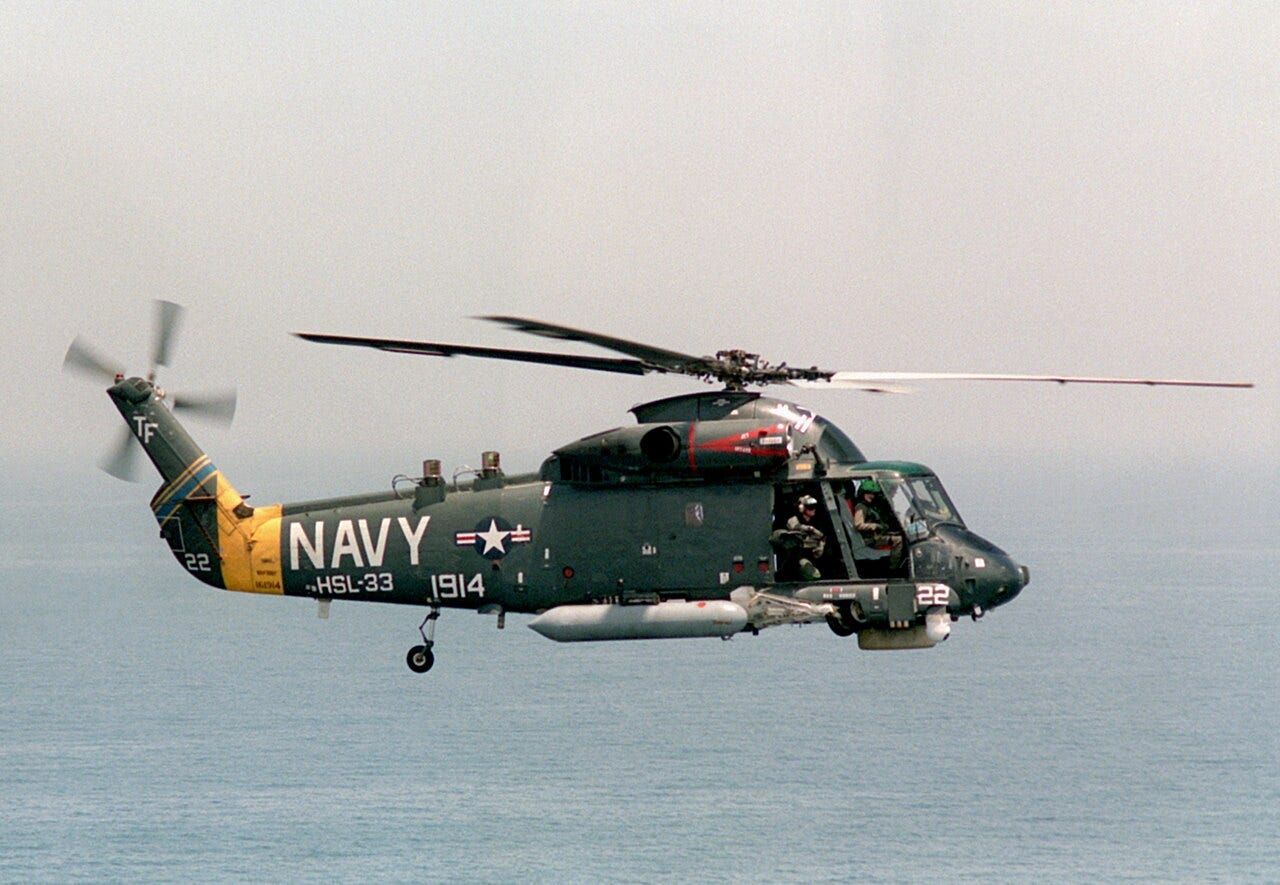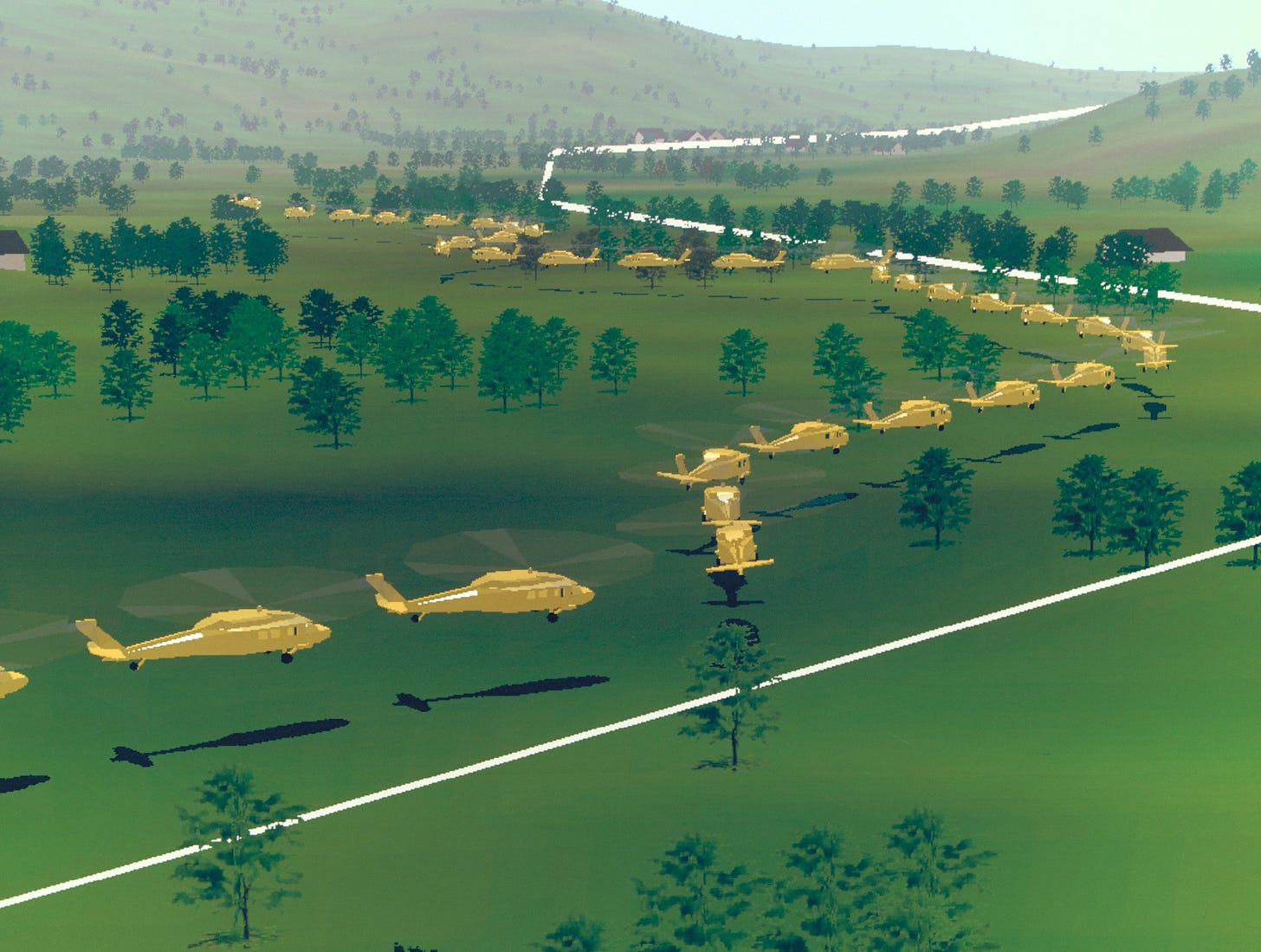Simulated Seasprites (ERI Pt. 8.5)
An addendum to previous post.
Anti-submarine warfare is not the flashiest role in a fleet air arm, but it is one of the most important. When World War I showed that submarines posed an unmitigated threat to naval convoys, the nations of the world rapidly developed ways to counter these undersea menaces. The problem was detection and safety. While a surface vessel could attempt to find a submarine underwater, being in the same medium as the sub meant it was exposed to the enemy’s weapons. Airplanes provided a better solution, but could not stay in one position for a period of time. Searching for submarines meant aircrews needed to circle for hours over a spot, dropping weapons and attempting to use radar and sonar to find their quarry. Eventually fuel ran out, forcing the crews to return to an airfield, leaving the convoys without air cover.
Anti-submarine warfare is just one of many special tasks airplanes are ill-suited for due to their inherently mobile nature. After World War II, the helicopter changed that. With a hovering flying machine, aircrews could remain in one location, dropping down to surface level and back up with ease. Early helicopters found use in utility roles like trucking around supplies or search and rescue.
In the 1960s the United States Navy was looking for a small helicopter to fill these roles in fleet operations. The Kaman corporation responded with the UH-2 Seasprite, an unflashy machine that was roughly equivalent to the Army’s soon-to-be-iconic UH-1 Huey. Entering service just in time for the Vietnam War, the Seasprite patrolled the waters off the shore, rescuing airmen shot down during bombing raids into the North. However, it was not particularly good at this. The Seapsrite had only one engine at a time where naval aviators preferred two for the added insurance in case of engine failure. The Seasprite was upgraded with a second engine, but the Navy already had better equipped utility helicopters. What they did not have was an anti-submarine helicopter that could operate from all its ships, not just the building-sized aircraft carriers.
The SH-2F Seasprite was designed to fill the gap. Leaving behind its workhorse background, the Seasprite became a sophisticated underwater detection machine. Loaded up with dippable sonars, listening devices, and torpedoes, a Seasprite could hover over a suspected submarine while staying close to its home ship. They could be launched quickly to provide a net of sonars around a vulnerable carrier battle group.
Playing the world’s most complicated game of hide-and-go-seek was not easy on the crews. Having to split their time between flying the Seasprite while operating its cutting-edge tech provided a massive challenge, and in the Cold War one mistake could mean a submarine would slip through the gaps to torpedo a nuclear-powered aircraft carrier.
To give its anti-submarine crews the practice they needed, the Navy invested in its first high-fidelity digital simulator for helicopters, the 2F106. It was a masterpiece of 70s computer engineering. The simulator wrapped the crew with high definition screens, using early CGI to simulate everything from a calm ocean to a torrential downpour. Banks of computers ran thousands of calculations to create a virtual helicopter in their silicon minds, accurately replicating the way a SH-2F would fly in real-life. Nowadays we’d call this virtual reality.
The system was so effective that it remained in use through the 80s, and this is where the Eyring Research Institute gets involved. The Navy put out a RFI to upgrade the 2F106 with a new set of computers and an updated operating system. The ERI, having experience working with military computer systems, responded and got the contract. Besides the interesting technical information in the linked software development plan, this is the first document I have come across that includes the ERI org chart. Like with many things about this institute, the organizational structure remains opaque. I had to dig into an obscure declassified software development plan for a simulator for an obsolete naval helicopter to find it.
The primary mission was to get the 2F106 to run on the Harris 800 — a cabinet-sized computer decked in resplendent creamy plastic — using the VOS operating system. The contract was worth $468,000 (around $1.3 million today) and as far as I can tell the project went smoothly. So smoothly, in fact, that the ERI lodged a complaint with the Government Accountability Office when a second contract went up in 1992 and they did not receive it. This contract was for improvements to the audiovisual system of the 2F106 and two similar simulators for the Seahawk helicopter. The ERI protested that the winner had incorrectly advertised its technical skills on points such as the computation of haze effects, the polygon count in the terrain models, and the refresh rates of the screens. The GAO denied the petition.
Helicopter simulators are almost pedestrian, but it was one example of the ERI’s ability to create a virtual world. The Minuteman simulation from the previous newsletter had much broader consequences than teaching pilots how to land in rain.




